ATP its uses and functions
Introduction
Like everything else, cells need energy for performing various activities which are vital for life and living beings. This energy comes from various sources or currencies and ATP is one of the major energy currencies of cells. ATP stands for Adenosine Triphosphate and it is a nucleotide.
ATP
The structure of ATP can be seen in the adjoining figure. The molecular formula is C10H16N5O13P3 and the various elements can be seen in the image. The wavy red lines represent the high energy bonds which release energy during hydrolysis.
Before ATP can release energy it has to be produced. ATP production is a chemical process formed from a reaction between adenosine diphosphate and inorganic phosphate. The result is the formation of ATP and water. The reaction itself requires significant amounts of energy (which is of the order of 7.3 kcal/mole) and the process takes place through various modes such as glycolysis, photosynthesis and cellular respiration.
When the reaction takes place the other way round during metabolic processes, the same amount of energy is released and hence ATP acts as the source of energy. The reaction in this case is given by
ATP + HO → ADP + P + Free Energy
Energy Source
There are several types of activities which require energy within the cell and ATP acts as a power source for them. Some of these activities are as follows:
- Anabolic reactions such as synthesis of fats, polysaccharides etc require energy for their completion.
- Nerve Impulses and cell signaling is another area in which ATP plays an important role.
- Several living beings emit light that is known as bioluminescence and ATP comes into the picture by supplying the requisite energy which is converted into light. Such ability is found in several marine animals, terrestrial animals and some types of bacteria.
- The transportation of ions and molecules across the membranes of the cell requires energy if the transport is from a region of lower concentration to a higher concentration (active transportation). The reverse process though takes place without the use of such energy and is known as diffusion or passive transport.
The above list is not exhaustive and there are several other activities which use ATP as their energy source. ATP is also useful in providing energy for several external processes which can include transmission of pain signals from damaged cells to the brain.
References
Image - ATP Structure
